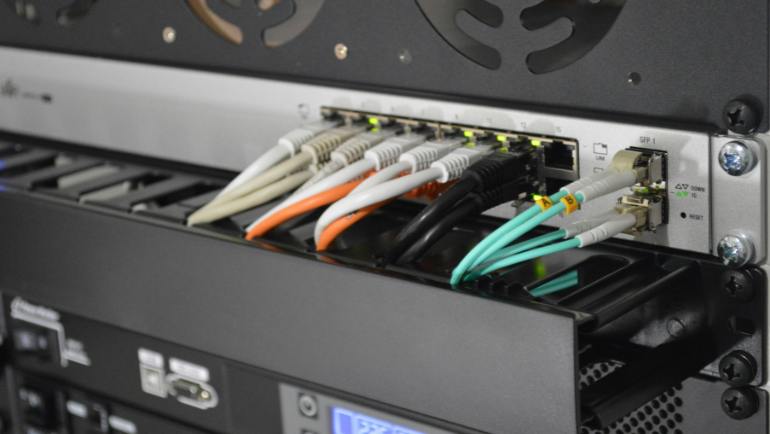
Wi-Fi technology has improved significantly in recent years, but it’s not one-size-fits-all, especially when it comes to businesses. Most firms experience dead zones and a limited number of connected devices on a single network. To address this, networking manufacturers invented wireless access points, leading enterprises to rely on them over other wireless devices. Businesses with large office spaces and heavy traffic utilize Wi-Fi access points as they offer many benefits that include better mobility, collaboration, and scalability.
What is a Wireless access point?
Symbol Technology was the first company who manufacture the first wireless access point in the mid-1990s. Since then, wireless access points have become integral components of Wi-Fi networks, providing connectivity to devices in workspaces, offices, and enterprises.
A Wireless Access Point (WAP) is a hardware component of your network and it bridges through radio waves between wireless-enabled devices and wired network devices. Wireless access points assist in accommodating the expansion of wireless network devices while maintaining reliable internet connectivity.
How does a Wireless Access Point work?
A Wireless access point connects the wired switch with the router through a network cable and broadcasts one or more Service Set Identifiers (SSID). Wired and wireless networks follow different networking standards: Ethernet standards for wired and IEEE 802.11 (Wi-Fi) standards for wireless. Most network devices are designed to support only one of these standards. However, WAPs are capable of supporting both. They can receive a data frame formatted with Wi-Fi standards, reformat it to wired Ethernet standards, and vice versa.
WAP supports seamless roaming between multiple WAPs and offers management features like configuration, monitoring, and quality of service (QoS). It also provides advanced technologies like Multiple Input Multiple Output (MIMO) and mesh networks to enhance performance and coverage.
Types Of Wi-Fi Access Points
Access points (AP) can be classified into different types based on their functionalities. Understanding these classifications helps in selecting the right WAP for specific needs.
- Standalone WAP
- Multifunction WAP
- Controlled WAP
Standalone WAP
A standalone access point works the same way as a switch or hub and accepts frames at the data link layer of the OSI model. It forwards the data to the connected devices based on their physical address. Standalone WAP is the most common type mostly used in large networks such as offices and enterprises.
Multifunction WAP
A multifunction wireless access point provides more functionalities by combining the networking features of two or more wireless devices. It has the capabilities of ethernet switches and routers that can eliminate the need to buy these devices separately. This results in simplicity, ease of use, and better space optimization.
The multifunction wireless access point offers wireless and routing capabilities, switching features, firewalls, and centralized management. However, if you increase the budget, you’ll get more features but they vary from different models.
Controlled WAP
Controller-based Wi-Fi access points also known as Lightweight Access Points (LWAPs), are important for modern enterprise wireless networks. These APs are managed centrally by a Wireless LAN Controller (WLC), which offloads most of the configuration and intelligence tasks from the APs themselves. This architecture allows simplified management, seamless handoff between multiple access points, and enhanced scalability, making it ideal for large-scale deployments.
Why Businesses Need a Wireless Access Points
Most organizations with large workspaces and employees can experience dead zones and installing a router in every corner can be costly. Wi-Fi access points can handle a large number of devices with up to 60 simultaneous connections. Installing access points throughout the office allows users to move from room to room without experiencing network interruptions. Devices within the network automatically transition from one access point to another while maintaining a seamless connection.
Configuration and Setup of Wireless Access Point
Setting up a wireless access point device involves many key steps to ensure you get optimal performance and security.
- Position the Wireless access point devices centrally to maximize your internet coverage and also ensure there are few walls and obstructions.
- Use an ethernet cable to connect the WAP to your router or switch allowing the access point to communicate with the existing network.
- Access the configuration page through your browser then set up SSID and security protocols.
Difference Between Access Points And Router
Following are the primary differences between a router and a WAP. Recognizing these differences is crucial for designing and managing effective network solutions.
| Feature | Access Point (AP) | Router |
| Function | Provides wireless connectivity to Wi-Fi-enabled devices. | Connects different networks, |
| Network Layer | Operates at the data link layer (Layer 2) of the OSI model. | Operates at the network layer (Layer 3) of the OSI model. |
| Configuration | Simpler with fewer parameters | Complex with more parameters to look after |
Range of WAP
The range of a WAP is influenced by many factors like Wi-Fi standards, antenna type, and obstacles. Advanced Wi-Fi standards such as 802.11ac and 802.11ax, generally offer a longer range compared to older standards like 802.11b and 802.11g.
- 802.11b/g: It can reach up to 150 feet (46 meters) indoors and 300 feet (92 meters) outdoors.
- 802.11a: It can go up to 100 feet (30 meters) indoors and 300 feet (92 meters) outdoors.
- 802.11n: can go up to 300 feet (92 meters) indoors and 600 feet (183 meters) outdoors.
- 802.11ac: up to 750 feet (229 meters) indoors and 1,500 feet (457 meters) outdoors.
- 802.11ax up to 1,000 feet (305 meters) indoors and 2,500 feet (762 meters) outdoors.
Security of Wireless Access Point
Wireless access points (WAPs) offer a variety of security features to protect your Wi-Fi network from unauthorized user access and eavesdropping. Modern wireless access point security support protocols like WPA2, WPA3, and AES (Advanced Encryption Standard) encryption to protect the data.
Moreover, WAPs offer a pre-shared key (PSK), a shared password that all authorized devices must possess. Enabling these features and keeping your WAP software up-to-date can significantly improve the security of your wireless network.
Advantages and Disadvantages of WAP
Every networking device has been built for a specific reason, which means it can be lacking in other areas. Below are the advantages and disadvantages of Wi-Fi access points.
| Advantages | Disadvantages |
| More User Access | High Cost |
| Broader Range of Transmission | Inability to be used alone |
| Flexible Networking | Poor Stability |
| Multi AP Connection |
Applications Of Access Points
The following are the most common applications of wireless access point speed
Device Capacity Expansions
WAP offers more advanced user handling than other wireless devices which gives it an edge for enterprises. Instead of installing multiple routers or extenders, businesses can install an access point that can cater to more users with a better range. Overall, It helps increase the overall user capacity of the network.
Full Area Coverage
Enterprises with large areas opt for wireless access points that routers, extenders or repeaters can not accommodate. WAPs ensure network coverage in the entire area to eliminate all the dead zones and provide seamless connectivity.
Signal Range Extension
Wireless APs increase the signal range and strengthen the Wi-Fi. Optimally mounted APs offer complete wireless coverage and eliminate “dead spots,” especially in large office spaces, conference centers, hotels, resorts, etc.
Price range of wireless access points
A wireless access point may range from $30 to $5145. The entry-level model is affordable and can cater few users like a router. However, if you choose a more expensive model you will have superior performance and more stable coverage with better user handling. Computing World has a variety of best wireless access points from popular IT hardware brands for sale online.
You can also request a bulk quote online for the top WAPs.
Future Trends
In 2024, AT&T and Ericson are collaborating to improve the overall networking ecosystem which will result in significant improvement. Moreover, WAP is expected to offer better Wi-Fi standards, and security like Wi-Fi 6E, Wi-Fi 7, and WPA3 are set to revolutionize wireless networking. These developments offer higher data rates, increased capacity, and improved security measures.
Frequently Ask Questions
Can I upgrade or expand my existing WAP setup?
Yes, you can upgrade or improve your existing wireless WAP setup.
Can I use a WAP for outdoor wireless coverage?
Yes, there are dedicated WAP models designed specifically for outdoor use, aimed at providing wireless coverage in outdoor environments.
Is a wireless internet access point the same as a Wi-Fi extender?
Access points extend network coverage over larger areas, whereas range extenders enhance coverage in smaller, specific areas.
Overall, a wireless internet access point is a must-have tool for most Multinational Companies (MNCs) and big tech firms to ensure a reliable internet connection. It makes the firm cost-efficient by installing one or more WAPs depending on the need. However, for smaller dead zones you can buy a Wi-Fi extender or you can also use your router as an extender.
To know such information about wireless access points and other wireless networking devices stay connected to the Computing Worlds blog.






